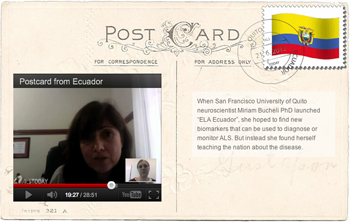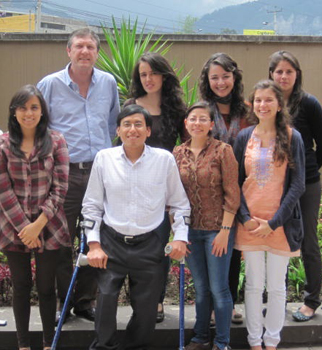
Postcard from Quito. Miriam Bucheli PhD talks about ELA-Ecuador and how she hopes the project will help the nation.
Physicians knew children in the 1920s lived in a “lead world”. Mild cases of colic and muscle spasms were commonplace due to the ingestion of paint chips. And, children were sickened by drinking water delivered by lead pipes.
Lead became tightly regulated. By 1978, only lead-free paints could be found at the local hardware store. Cars could run on unleaded gasoline. Copper pipes delivered drinking water. And, lead-free earthenware could be found on dinner tables throughout the US.
But high in the Andean mountains, the indigenous peoples of Ecuador cling to the old ways. Huddling around bubbling cauldrons of molten lead now salvaged from old car batteries, potters continue to create shiny ceramic lead-glazed roof tiles that Ecuadorian homeowners crave.
The lead levels, estimated to be more than 10 times higher than the limit recommended by the US' Centers for Disease Control and Prevention, have been linked to learning deficits. And, scientists suspect, may even predispose people later in life to develop ALS.
Now, researchers from the San Francisco University of Quito in Ecuador led by neuroscientist Miriam Bucheli PhD hope to determine whether chronic lead exposure contributes to ALS and results in increased cases of the disease.
“A link to ALS could create awareness [and] encourage people to change their lifestyles because the disease is so debilitating” says Bucheli.

Team ELA-Ecuador. Project coordinator Ivan Sisa MD and epidemiologist Marco Fornasini MD PhD. Also pictured left to right, USFQ medical students Priscila Villalba, Alejandra Mendoza, Diana Chicaiza, Carolina Franco, Barbara Mantilla and Amelia Calderon. Image courtesy of Miriam Bucheli PhD. Reproduced with permission.
The study is part of a growing effort, called ELA-Ecuador, to unravel the genetics and environmental influences that contribute to the disease.
Nearly 20 genes by some estimates are linked to ALS. But mutations in these genes alone, scientists suspect, may not result in ALS. Other factors such as chemical exposures, lifestyle choices and viral infections are also speculated to contribute to the onset of the disease.
Scientists hope to identify these risk factors in part, by interviewing people at high risk for developing the disease.
In the US, researchers at the University of Miami led by neurologist familial ALS-associated mutations. And, a multi-institutional US team led by Duke University School of Medicine epidemiologist Silke Schmidt DSc MS hopes to discover why US veterans appear to be about twice as likely to develop the disease.
Now, the ELA-Ecuador team is turning to the same epidemiologist, Stanford University School of Medicine's Lorene Nelson PhD, to conduct the same kinds of interviews, in hopes to identify risk factors including lead exposure in people from the Andean region.
“We are using the same questionnaires,” explains Bucheli, “so that we can eventually compare the data from other countries.”
Southern Exposure
Lead overexposed. High lead exposure is common in people who live in the Andes mountains. Video: S. Allen Counter DMSc PhD, Harvard University.
Lead exposure has been suspected for decades to be a possible risk factor for ALS because the toxic substance can damage the central nervous system.
Some studies suggest that higher lead levels could increase the risk of developing ALS. But other studies have been inconclusive.
A big part of the problem is that these studies are extremely difficult to do. Circulating lead levels can increase during the disease course due to bone breakdown making total levels tricky to estimate. And the difference in lead levels can be difficult to determine because the levels in circulation are relatively small.
By studying a large population of people exposed daily to high levels of lead, Bucheli hopes to be able to finally determine whether or not lead exposure contributes to ALS. And at the same time, help people reduce their risk of developing the disease.
“If you know you have a higher risk for ALS, you may choose to change rather than continue old practices,” says Bucheli.
References
Counter, S.A., Buchanan, L.H. and Ortega F. (2005) Neurocognitive impairment in lead-exposed children of Andean lead-glazing workers. Journal of Occupational and Environmental Medicine 47(3), 306-312. Abstract | Full Text (Subscription Required)
Counter, S.A. et al. (2000). Environmental lead contamination and pediatric lead intoxication in an Andean Ecuadorian village. International Journal of Occupational and Environmental Health 6(3), 169-176. Abstract | Full Text (Subscription Required)
Counter, S.A., Buchanan, L. H., Ortega, F., and Rifai, N. (2000). Blood lead and hemoglobin levels in Andean children with chronic lead intoxication. Neurotoxicology 21(3), 301-308. Abstract | Full Text (Not Online)
Counter, S.A., Buchanan, L.H., Rosas, H.D. and Ortega F. (1998) Neurocognitive effects of chronic lead intoxication in Andean children. Journal of Neurological Sciences 160(1), 47-53. Abstract | Full Text (Subscription Required)
Fang, F. et al. (2010) Association between blood lead and the risk of amyotrophic lateral sclerosis. American Journal of Epidemiology 171(10), 1126-1133. Abstract | Full Text
Haley, R.W. (2003) Excess incidence of ALS in young Gulf War veterans. Neurology 61(6), 750-756. Abstract | Full Text
Horner, R.D. et al. (2003) Occurrence of amyotrophic lateral sclerosis among Gulf War veterans. Neurology 61(6), 742-749. Abstract | Full Text
Ruddock, J.C. (1924) Lead poisoning in children. Journal of the American Medical Association 82(21), 1682-1684. Full Text
Schmidt, S. et al. (2008) Genes and environmental factors in veterans with amyotrophic lateral sclerosis: the GENEVA study. Neuroepidemiology 30(3), 191-204. Abstract | Full Text
Further reading
Ahmed, A. and Wicklund, M.P. (2011) Amyotrophic lateral sclerosis: what role does environment play? Neurologics Clinics 29(3), 689-711. Abstract | Full Text (Subscription Required)
Callaghan B., Feldman D., Gruis K. and Feldman, E. (2011) The association of exposure to lead, mercury, and selenium and the development of amyotrophic lateral sclerosis and the epigenetic implications. Neurodegenerative Diseases 8(1-2), 1-8. Abstract | Full Text (Subscription Required)
Patient Resources
ELA-Ecuador. Contact | ALS TDI | Website
The Pre-Familial Amyotrophic Lateral Sclerosis (Pre-fALS) Study. Contact | ALS TDI | Website